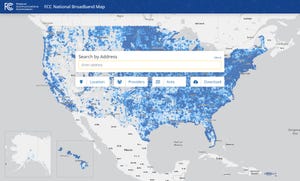
FCC’s New Coverage Maps Show 8.3 Million Americans Lack High-Speed Internet - CNET
FCC’s New Coverage Maps Show 8.3 Million Americans Lack High-Speed Internet
The agency is slowly painting a more accurate picture of broadband access across the US.
In November, the Federal Communications Commission released its first version of radically revamped coverage maps to accurately show which areas have high-speed internet. After gathering feedback and refining data, the agency on Tuesday published its first major progress report, which noted over 8.3 million US homes and businesses don’t have access to high-speed broadband internet.
Previously, the FCC relied on data from 8.1 million census blocks for its coverage maps, assuming that if one location had high-speed broadband then all neighbors must as well. The new broadband coverage maps are far more granular, showing access results down to the level of 114 million homes and businesses across the country.
Feedback and map refinements have revealed 330,000 more locations that don’t have high-speed internet than in previous maps, according to an FCC press release. The maps are being regularly updated and have added 1 million locations since the first version was released in November.
Those new locations are the result of extensive responses from homeowners and businesses as well as internet service providers, which the FCC reviewed to determine reliable access to high-speed broadband (currently defined by the FCC as a minimum of 25Mbps download speed). Earlier in February, reports claimed the agency was investigating multiple service providers for exaggerating their high-speed internet availability.
The maps also show coverage for 5G mobile networks provided by major carriers.
Locating local internet providers
This is the first major report from the FCC explaining how its new maps are progressing, and the FCC has reiterated its commitment to twice-annual reviews to update the public on the last months of updated data. Presumably, we can expect another update on the maps before the end of 2023.
The new maps are the result of the Broadband DATA Act, which charged the FCC with publicly displaying where Americans can get high-speed wired internet access. The maps themselves are funded by $65 million from the Consolidated Appropriations Act of 2021.
Separately, the US is spending $65 billion to improve access to high-speed internet, which is a slice of the $1.2 trillion infrastructure act that passed in 2021. Broadband access was already an issue holding back millions of Americans from joining an increasingly online-centered world, but the global Coronavirus pandemic exacerbated the issue, cutting them off outright from communities and commerce as lockdowns isolated the country.
Read more: Millions of Americans can’t get broadband because of a faulty FCC map. There’s a fix
The new FCC coverage maps are part of the process of closing the digital divide by identifying where connectivity still falls short. While refining the maps is an iterative process, the agency’s report shows it is slowly painting a more accurate picture of broadband access across the US.
If you need help choosing the best high-speed internet providers, here’s CNET’s list across cable, fiber and 5G, and 10 tips to ensure you get the best broadband service.
If you’ve just moved into a new home, here’s how to get your internet going as soon as possible, and if you’ve been there for a while and want to switch broadband providers, here are our tips for that.
Read more: Home Internet Cheat Sheet: Deals, Plans and Much More Revealed

